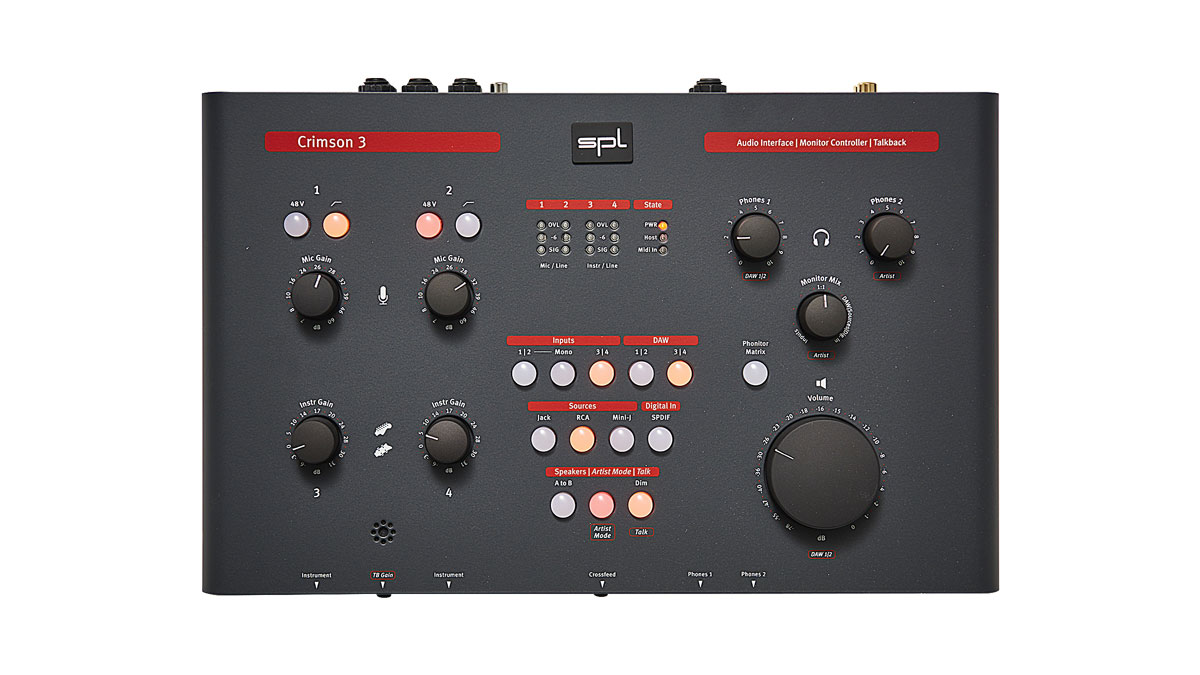MusicRadar Verdict
Crimson 3’s new developments are welcome, and the Phonitor Matrix makes listening on headphones more like using monitors. At this price, it’ll appeal to those seeking this particular feature set.
Pros
- +
Rugged, high-build quality.
- +
Great-sounding recording channels.
Cons
- -
Takes up fair chunk of desk space.
MusicRadar's got your back
SPL has a reputation as a serious audio developer with a specialism in hardware channel strips, monitor controllers and, of course, the much-loved Transient Designer.
In a way, its Crimson audio interfaces combine a couple of these technologies, offering a high-quality recording path coupled with a flexible monitor controller, to provide an audio interface at the heart of your recording rig. So what’s new in Crimson 3?
First up, let’s have a look around. Available in both black and white finishes, Crimson 3 is a laptop-sized, desktop-based, wedge-shaped interface, with preamp controls on the left-hand side of its upper panel. These provide phantom power and high-pass filter switches for mic/line inputs 1 and 2, with a rotary control underneath providing gain.
There’s no doubt that Crimson 3 is a thoroughly capable and high-quality sounding audio interface, with some really nicely thought-through additions
Below these, two more instrument/line inputs are provided, whilst the central section provides a matrix array of buttons to control Inputs, monitor DAW return levels, select from all connected sources, enable S/PDIF digital inputs as well as engage the new, integrated Talkback microphone, introduced for Crimson 3.
The right-hand side of the upper surface concerns itself with the Monitor Controller section, with playback volume from your DAW controlled by a prominent rotary at the bottom. Two independent headphone outputs are provided for both you (the producer) and your recording artist, whilst input connections are made on the rear panel.
Round the back, the ‘modules’ for each section are labelled both the right way up and upside down, so it’s clear what needs patching where, whether you’ve moved to the back of the interface, or whether you’re leaning over it from the front.
In both cans
Perhaps the most significant new feature added to Crimson 3 is SPL’s ‘Phonitor Matrix’. Whenever you’re working on headphones, either at the tracking or mixing stage, stereo width is exaggerated, as there’s none of the ‘bleed’ from left to right (or vice versa) you’ll experience on a pair of studio monitors.
Want all the hottest music and gear news, reviews, deals, features and more, direct to your inbox? Sign up here.
Whereas a portion of any sound panned hard left will still reach your right ear when working on speakers, this isn’t the case on headphones, often leading to cautious pan positions at the mix stage. Crimson 3’s Phonitor Matrix superimposes ‘speaker-like’ stereo imaging to the headphone ports, producing a more natural listening environment whilst working.
There’s no doubt that Crimson 3 is a thoroughly capable and high-quality sounding audio interface, with some really nicely thought-through additions. Its Monitor Control options are strong and the Phonitor Matrix encourages bolder stereo positions for anyone mixing on headphones - a hugely welcome and intuitive feature.
The main sticking point here is the price; in terms of I/O, Crimson 3 isn’t significantly specified beyond some of its rivals, and whilst its control surface is immediately tactile and ready to aid workflow nicely, you’ll have to decide whether these features are worth the premium. If you do decide to push your cash in SPL’s direction, there’s no doubt you’ll receive a high-quality audio interfacing and monitor controlling solution in return.
